NCERT Solutions for Miscellaneous Exercise Chapter 12 Class 12 - Linear Programming
CBSE Class 12th Exam Date:01 Jan' 26 - 14 Feb' 26
NCERT Solutions For Class 12 Chapter 12 Miscellaneous Exercise
NCERT Solutions for miscellaneous exercise chapter 12 class 12 Linear Programming are discussed here. These NCERT solutions are created by subject matter expert at Careers360 considering the latest syllabus and pattern of CBSE 2023-24. NCERT solutions for Class 12 Maths chapter 12 miscellaneous exercise gives more knowledge of solving a few types of linear programming problems using graphical methods. Miscellaneous exercise chapter 12 Class 12 are solved in a detailed manner with necessary steps and graphs. Going through NCERT solutions for Class 12 Maths chapter 12 miscellaneous exercise gives a better understanding of the linear programming problems. The questions discussed in the NCERT book Class 12 Maths chapter 12 miscellaneous solutions are a bit higher level as compared to the other two exercises. Class 12 Maths chapter 12 miscellaneous solutions are important for Class 12 CBSE Board Exams.
Miscellaneous exercise class 12 chapter 12 are designed as per the students demand covering comprehensive, step by step solutions of every problem. Practice these questions and answers to command the concepts, boost confidence and in depth understanding of concepts. Students can find all exercise enumerated in NCERT Book together using the link provided below.
Linear Programming Class 12 Chapter 12-Miscellaneous Exercise
Question:1 Reference of Example 9 (Diet problem): A dietician has to develop a special diet using two foods P and Q. Each packet (containing 30 g) of food P contains 12 units of calcium, 4 units of iron, 6 units of cholesterol and 6 units of vitamin A. Each packet of the same quantity of food Q contains 3 units of calcium, 20 units of iron, 4 units of cholesterol and 3 units of vitamin A. The diet requires atleast 240 units of calcium, atleast 460 units of iron and at most 300 units of cholesterol.
How many packets of each food should be used to maximise the amount of vitamin A in the diet? What is the maximum amount of vitamin A in the diet?
Answer:
Let diet contain x packets of food P and y packets of food Q. Thus, $x\geq 0,y\geq 0$ .
The mathematical formulation of the given problem is as follows:
Total cost is Z . $Z=6x+3y$
Subject to constraint,
$4x+y\geq 80$
$x+5y\geq 115$
$x\geq 0,y\geq 0$
The feasible region determined by constraints is as follows:
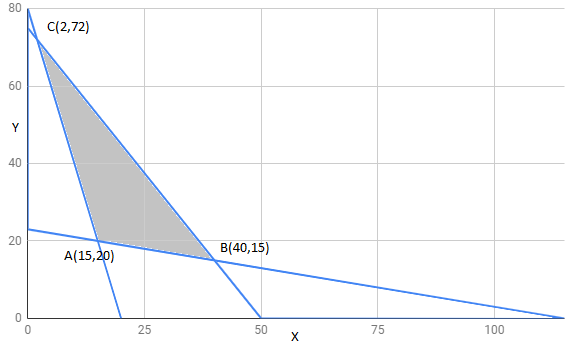
The corner points of feasible region are $A(15,20),B(40,15),C(2,72)$
The value of Z at corner points is as shown :
| corner points | $Z=6x+3y$ | |
| $A(15,20)$ | 150 | MINIMUM |
| $B(40,15)$ | 285 | maximum |
| $C(2,72)$ | 228 |
Hence, Z has a maximum value of 285 at the point $B(40,15)$ .
to maximise the amount of vitamin A in the diet, 40 packets of food P and 15 packets of food Q should be used. The maximum amount of vitamin A is 285 units.
Answer:
Let farmer mix x bags of brand P and y bags of brand Q. Thus, $x\geq 0,y\geq 0$ .
The given information can be represented in the table as :
| Vitamin A | Vitamin B | Cost | |
| Food P | 3 | 5 | 60 |
| Food Q | 4 | 2 | 80 |
| requirement | 8 | 11 |
The given problem can be formulated as follows:
Therefore, we have
$3x+1.5y\geq 18$
$2.5x+11.25y\geq 45$
$2x+3y\geq 24$
$Z=250x+200y$
Subject to constraint,
$3x+1.5y\geq 18$
$2.5x+11.25y\geq 45$
$2x+3y\geq 24$
$x\geq 0,y\geq 0$
The feasible region determined by constraints is as follows:
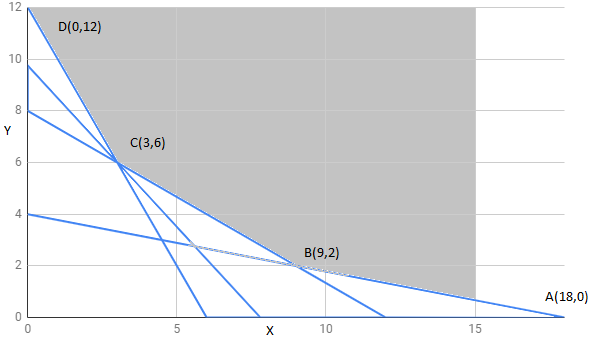
The corner points of the feasible region are $A(18,0),B(9,2),C(3,6),D(0,12)$
The value of Z at corner points is as shown :
| corner points | $Z=250x+200y$ | |
| $A(18,0)$ | 4500 | |
| $B(9,2)$ | 2650 | |
| $C(3,6)$ | 1950 | minimum |
| $D(0,12)$ | 2400 |
Feasible region is unbounded, therefore 1950 may or may not be a minimum value of Z. For this, we draw $250x+200y< 1950$ and check whether resulting half plane has a point in common with the feasible region or not.
We can see a feasible region has no common point with $250x+200y< 1950$ .
Hence, Z has a minimum value 1950 at point $C(3,6)$ .
| Food | Vitamin A | Vitamin B | Vitamin C |
| X | 1 | 2 | 3 |
| Y | 2 | 2 | 1 |
One kg of food X costs Rs 16 and one kg of food Y costs Rs 20. Find the least cost of the mixture which will produce the required diet?
Answer:
Let mixture contain x kg of food X and y kg of food Y.
Mathematical formulation of given problem is as follows:
Minimize : $z=16x+20y$
Subject to constraint ,
$x+2y\geq 10$
$x+y\geq 6$
$3x+y\geq 8$
$x,y\geq 0$
The feasible region determined by constraints is as follows:
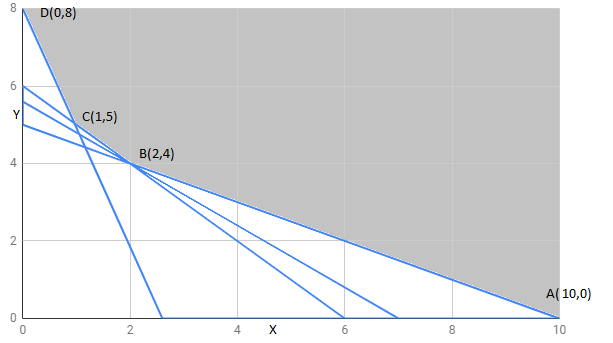
The corner points of feasible region are $A(10,0),B(2,4),C(1,5),D(0,8)$
The value of Z at corner points is as shown :
| corner points | $z=16x+20y$ | |
| $A(10,0)$ | 160 | |
| $B(2,4)$ | 112 | minimum |
| $C(1,5)$ | 116 | |
| $D(0,8)$ | 160 |
The feasible region is unbounded , therefore 112 may or may not be minimum value of Z .
For this we draw $16x+20y< 112$ and check whether resulting half plane has point in common with feasible region or not.
We can see feasible region has no common point with $16x+20y< 112$ .
Hence , Z has minimum value 112 at point $B(2,4)$
| Types of toys | Machines | ||
| I | II | III | |
| A | 12 | 18 | 6 |
| B | 6 | 0 | 9 |
Each machine is available for a maximum of 6 hours per day. If the profit on each toy of type A is Rs 7.50 and that on each toy of type B is Rs 5, show that 15 toys of type A and 30 of type B should be manufactured in a day to get maximum profit.
Answer:
Let x and y toys of type A and type B.
Mathematical formulation of given problem is as follows:
Minimize : $z=7.5x+5y$
Subject to constraint ,
$2x+y\leq 60$
$x\leq 20$
$2x+3y \leq 120$
$x,y\geq 0$
The feasible region determined by constraints is as follows:
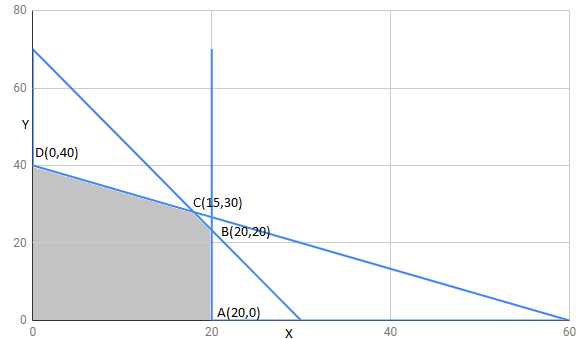
The corner points of feasible region are $A(20,0),B(20,20),C(15,30),D(0,40)$
The value of Z at corner points is as shown :
| corner points | $z=7.5x+5y$ | |
| $A(20,0)$ | 150 | |
| $B(20,20)$ | 250 | |
| $C (15,30)$ | 262.5 | maximum |
| $D(0,40)$ | 200 |
Therefore 262.5 may or may not be maximum value of Z .
Hence , Z has maximum value 262.5 at point $C (15,30)$
Answer:
Let airline sell x tickets of executive class and y tickets of economy class.
Mathematical formulation of given problem is as follows:
Minimize : $z=1000x+600y$
Subject to constraint ,
$x+y\leq 200$
$x\geq 20$
$y-4x\geq 0$
$x,y\geq 0$
The feasible region determined by constraints is as follows:
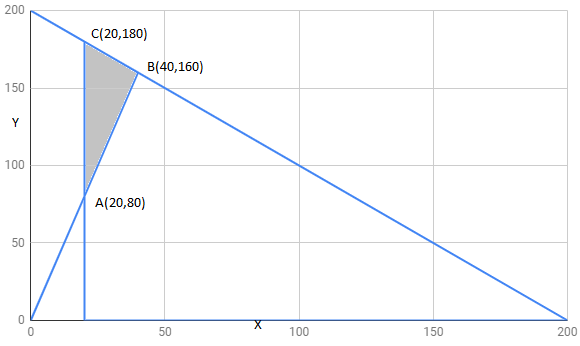
The corner points of feasible region are $A(20,80),B(40,160),C(20,180)$
The value of Z at corner points is as shown :
| corner points | $z=1000x+600y$ | |
| $A(20,80)$ | 68000 | |
| $B(40,160)$ | 136000 | maximum |
| $C (20,180)$ | 128000 | |
therefore 136000 is maximum value of Z .
Hence , Z has maximum value 136000 at point $B(40,160)$
| Transportation cost per quintal (in Rs) | ||
| From/To | A | B |
| D | 6 | 4 |
| E | 3 | 2 |
| F | 2.50 | 3 |
How should the supplies be transported in order that the transportation cost is minimum? What is the minimum cost?
Answer:
Let godown A supply x and y quintals of grain to shops D and E respectively. Then , (100-x-y) will be supplied to shop F. Requirements at shop D is 60 since godown A supply x .Therefore remaining (60-x) quintals of grain will be transported from godown B.
Similarly, (50-y) quintals and 40-(100-x-y)=(x+y-60) will be transported from godown B to shop E and F respectively. The problem can be represented diagrammatically as follows:
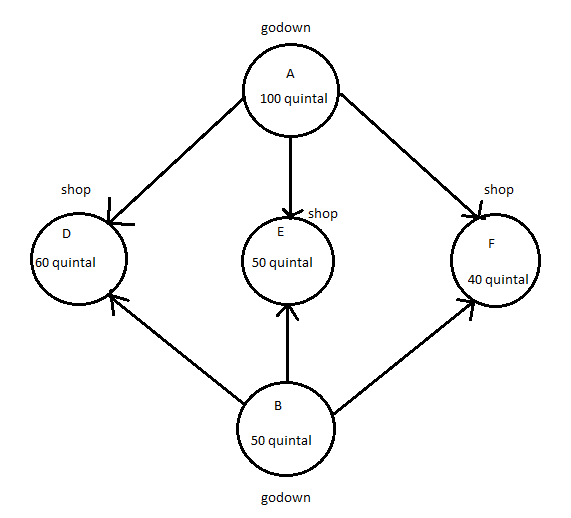
$x,y\geq 0$ and $100-x-y\geq 0$
$x,y\geq 0$ and $x+y\leq 100$
$60-x\geq 0,50-y\geq 0\, \, \, and\, \, x+y-60\geq 0$
$\Rightarrow \, \, \, \, x\leq 60,y\leq 50,x+y\geq 60$
Total transportation cost z is given by ,
$z=6x+3y+2.5(100-x-y)+4(60-x)+2(50-y)+3(x+y-60)$
$z=2.5x+1.5y+410$
Mathematical formulation of given problem is as follows:
Minimize : $z=2.5x+1.5y+410$
Subject to constraint ,
$x+y\leq 100$
$x\leq 60$
$y\leq 50$
$x+y\geq 60$
$x,y\geq 0$
The feasible region determined by constraints is as follows:
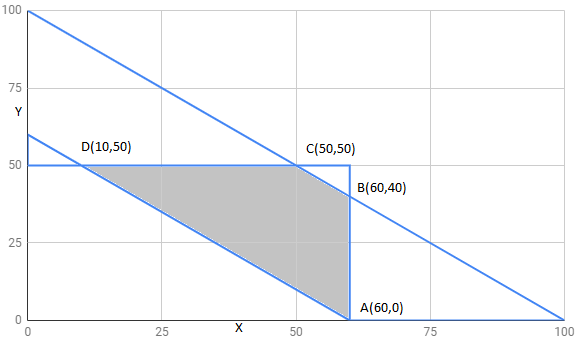
The corner points of feasible region are $A(60,0),B(60,40),C(50,50),D(10,50)$
The value of Z at corner points is as shown :
| corner points | $z=2.5x+1.5y+410$ | |
| $A(60,0)$ | 560 | |
| $B(60,40)$ | 620 | |
| $C(50,50)$ | 610 | |
| $D(10,50)$ | 510 | minimum |
therefore 510 may or may not be minimum value of Z .
Hence , Z has miniimum value 510 at point $D(10,50)$
| Distance in (km.) | ||
| From/To | A | B |
| D | 7 | 3 |
| E | 6 | 4 |
| F | 3 | 2 |
Assuming that the transportation cost of 10 litres of oil is Re 1 per km, how should the delivery be scheduled in order that the transportation cost is minimum? What is the minimum cost?
Answer:
Let x and y litres of oil be supplied from A to petrol pump,D and E. Then , (7000-x-y) will be supplied from A to petrol pump F.
Requirements at petrol pump D is 4500 L. since x L A are transported from depot A,remaining 4500-x L will be transported from petrol pump B
Similarly, (3000-y)L and 3500-(7000-x-y)=(x+y-3500) L will be transported from depot B to petrol E and F respectively.
The problem can be represented diagrammatically as follows:
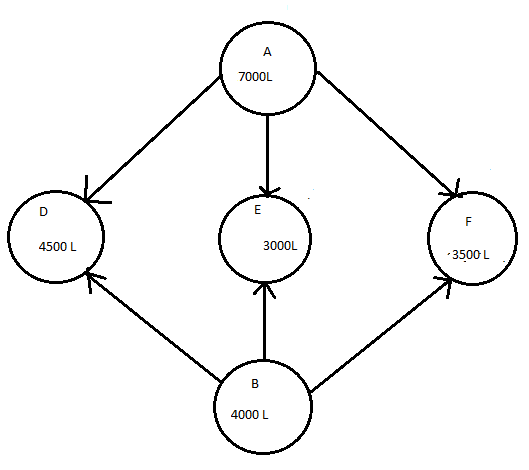
$x,y\geq 0$ and $7000-x-y\geq 0$
$x,y\geq 0$ and $x+y\leq 7000$
$4500-x\geq 0,3000-y\geq 0\, \, \, and\, \, x+y-3500\geq 0$
$\Rightarrow \, \, \, \, x\leq 4500,y\leq 3000,x+y\geq 3500$
Cost of transporting 10 L petrol =Re 1
Cost of transporting 1 L petrol $=\frac{1}{10}$
Total transportation cost z is given by ,
$z=\frac{7}{10}x+\frac{6}{10}y+\frac{3}{10}(7000-x-y)+\frac{3}{10}(4500-x)+\frac{4}{10}(3000-y)+\frac{2}{10}(x+y-3500)$
$z=0.3x+0.1y+3950$
Mathematical formulation of given problem is as follows:
Minimize : $z=0.3x+0.1y+3950$
Subject to constraint ,
$x+y\leq 7000$
$x\leq 4500$
$y\leq 3000$
$x+y\geq 3500$
$x,y\geq 0$
The feasible region determined by constraints is as follows:
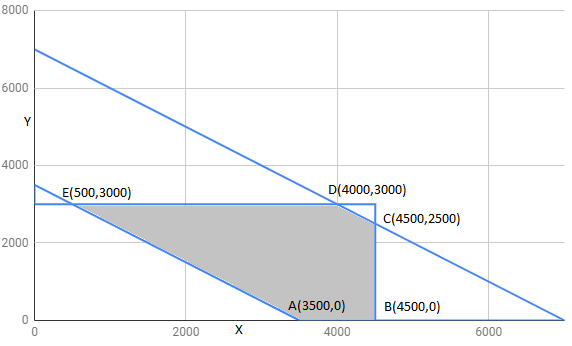
The corner points of feasible region are $A(3500,0),B(4500,0),C(4500,2500),D(4000,3000),E(500,3000)$
The value of Z at corner points is as shown :
| corner points | $z=0.3x+0.1y+3950$ | |
| $A(3500,0)$ | 5000 | |
| $B(4500,0)$ | 5300 | |
| $C(4500,2500)$ | 5550 | |
| $E(500,3000)$ | 4400 | minimum |
| $D(4000,3000)$ | 5450 |
Hence , Z has miniimum value 4400 at point $E(500,3000)$
If the grower wants to minimise the amount of nitrogen added to the garden, how many bags of each brand should be used? What is the minimum amount of nitrogen added in the garden?
| Kg per bag | ||
| Brand P | Brand Q | |
| Nitrogen | 3 | 3.5 |
| Phosphoric Acid | 1 | 2 |
| Potash | 3 | 1.5 |
| Chlorine | 1.5 | 2 |
Answer:
Let fruit grower use x bags of brand P and y bags of brand Q.
Mathematical formulation of given problem is as follows:
Minimize : $z=3x+3.5y$
Subject to constraint ,
$x+2y\geq 240$
$x+0.5y\geq 90$
$1.5x+2y\geq 310$
$x,y\geq 0$
The feasible region determined by constraints is as follows:
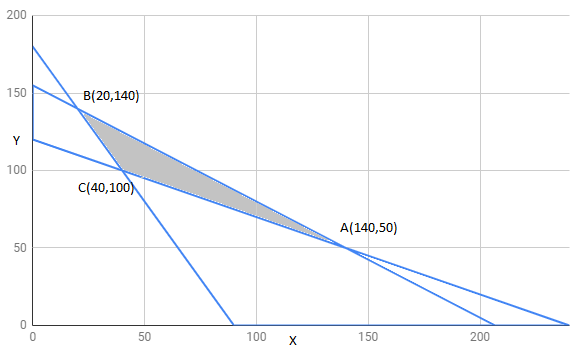
The corner points of feasible region are $A(140,50),C(40,100),B(20,140)$
The value of Z at corner points is as shown :
| corner points | $z=3x+3.5y$ | |
| $A(140,50)$ | 595 | |
| $B(20,140)$ | 550 | |
| $C(40,100)$ | 470 | minimum |
Therefore 470 is minimum value of Z .
Hence , Z has minimum value 470 at point $C(40,100)$
If the grower wants to maximise the amount of nitrogen added to the garden, how many bags of each brand should be added? What is the maximum amount of nitrogen added?
| Kg per bag | ||
| Brand A | Brand P | |
| Nitrogen | 3 | 3.5 |
| Phosphoric Acid | 1 | 2 |
| Potash | 3 | 1.5 |
| Chlorine | 1.5 | 2 |
Answer:
Let fruit grower use x bags of brand P and y bags of brand Q.
Mathematical formulation of given problem is as follows:
Maximize : $z=3x+3.5y$
Subject to constraint ,
$x+2y\geq 240$
$x+0.5y\geq 90$
$1.5x+2y\geq 310$
$x,y\geq 0$
The feasible region determined by constraints is as follows:
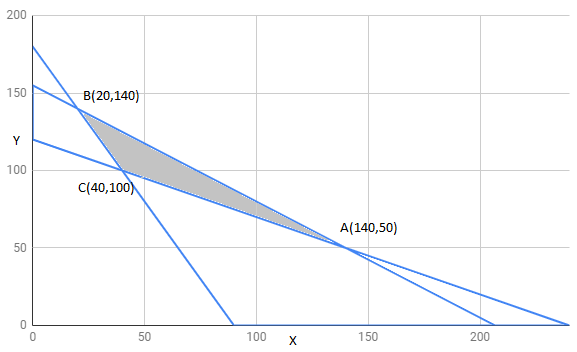
The corner points of feasible region are $B(20,140),A(140,50),C(40,100)$
The value of Z at corner points is as shown :
| corner points | $z=3x+3.5y$ | |
| $A(140,50)$ | 595 | maximum |
| $B(20,140)$ | 550 | |
| $C(40,100)$ | 470 | minimum |
therefore 595 is maximum value of Z .
Hence , Z has minimum value 595 at point $A(140,50)$
Answer:
Let x and y be number of dolls of type A abd B respectively that are produced per week.
Mathematical formulation of given problem is as follows:
Maximize : $z=12x+16y$
Subject to constraint ,
$x+y\leq 1200$
$y\leq \frac{x}{2}\Rightarrow x\geq 2y$
$x-3y\leq 600$
$x,y\geq 0$
The feasible region determined by constraints is as follows:
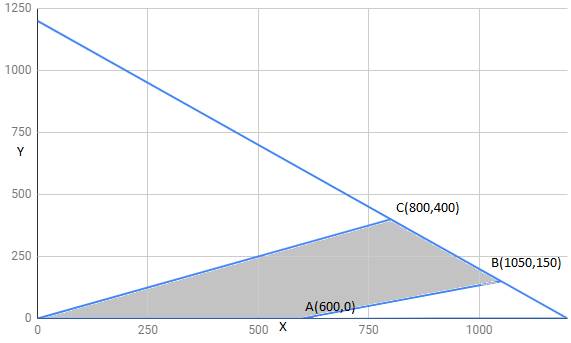
The corner points of feasible region are $A(600,0),B(1050,150),C(800,400)$
The value of Z at corner points is as shown :
| corner points | $z=12x+16y$ | |
| $A(600,0)$ | 7200 | |
| $B(1050,150)$ | 15000 | |
| $C(800,400)$ | 16000 | Maximum |
Therefore 16000 is maximum value of Z .
Hence , Z has minimum value 16000 at point $C(800,400)$
More About NCERT Solutions for Class 12 Maths Chapter 12 Miscellaneous Exercise:
There are 10 questions in the miscellaneous exercise chapter 12 Class 12. Solving all these questions gives a good knowledge about the NCERT Class 12th chapter linear programming. Students have to solve the NCERT syllabus exercises and solved examples in order to get a good idea of topics discussed in the chapter and to get a good score in the final exam.
Also Read| Linear Programming Class 12th Notes
Benefits of NCERT Solutions for Class 12 Maths Chapter 12 Miscellaneous Exercise.
- Important questions to understand the concepts explained in the chapter are given in Class 12 Maths chapter 12 miscellaneous exercise solutions.
- All questions of miscellaneous exercise chapter 12 Class 12 are important and will be helpful in the board exam.
Key Features Of NCERT Solutions For Class 12 Chapter 12 Miscellaneous Exercise
- Comprehensive Coverage: The solutions encompass all the topics covered in miscellaneous exercise class 12 chapter 12, ensuring a thorough understanding of the concepts.
- Step-by-Step Solutions: In this class 12 chapter 12 maths miscellaneous solutions, each problem is solved systematically, providing a stepwise approach to aid in better comprehension for students.
- Accuracy and Clarity: Solutions for class 12 maths miscellaneous exercise chapter 12 are presented accurately and concisely, using simple language to help students grasp the concepts easily.
- Conceptual Clarity: In this class 12 maths ch 12 miscellaneous exercise solutions, emphasis is placed on conceptual clarity, providing explanations that assist students in understanding the underlying principles behind each problem.
- Inclusive Approach: Solutions for class 12 chapter 12 miscellaneous exercise cater to different learning styles and abilities, ensuring that students of various levels can grasp the concepts effectively.
- Relevance to Curriculum: The solutions for miscellaneous exercise class 12 chapter 12 align closely with the NCERT curriculum, ensuring that students are prepared in line with the prescribed syllabus.
Also see-
NCERT Solutions Subject Wise
Subject Wise NCERT Exemplar Solutions
Frequently Asked Questions (FAQs)
One question of 5 marks can be expected
Three
Diet, manufacturing and transportation problems are discussed before the ncert solutions for Class 12 Maths chapter 12 miscellaneous exercise.
Constraints are rules or conditions that are used in optimization problems
There are three exercises including miscellaneous exercises.
Ten questions are covered in Class 12 Maths chapter 12 miscellaneous solutions
Questions related to CBSE Class 12th
On Question asked by student community
Failing in pre-board or selection tests does NOT automatically stop you from sitting in the CBSE Class 12 board exams. Pre-boards are conducted by schools only to check preparation and push students to improve; CBSE itself does not consider pre-board marks. What actually matters is whether your school issues your admit card. Some schools may pressure or warn students who fail multiple subjects, but legally they cannot detain you just because of pre-board results if your attendance and internal requirements are completed. In most cases, schools allow students to sit for boards after extra tests, remedial classes, or a written undertaking from parents. So don’t panic—but also don’t be careless. Use this as a wake-up call and seriously work on weak subjects instead of relying on hope alone.
Hello,
You can get the Class 11 English Syllabus 2025-26 from the Careers360 website. This resource also provides details about exam dates, previous year papers, exam paper analysis, exam patterns, preparation tips and many more. you search in this site or you can ask question we will provide you the direct link to your query.
LINK: https://school.careers360.com/boards/cbse/cbse-class-11-english-syllabus
Hello,
No, it’s not true that GSEB (Gujarat Board) students get first preference in college admissions.
Your daughter can continue with CBSE, as all recognized boards CBSE, ICSE, and State Boards (like GSEB) which are equally accepted for college admissions across India.
However, state quota seats in Gujarat colleges (like medical or engineering) may give slight preference to GSEB students for state-level counselling, not for all courses.
So, keep her in CBSE unless she plans to apply only under Gujarat state quota. For national-level exams like JEE or NEET, CBSE is equally valid and widely preferred.
Hope it helps.
Hello,
The Central Board of Secondary Education (CBSE) releases the previous year's question papers for Class 12.
You can download these CBSE Class 12 previous year question papers from this link : CBSE Class 12 previous year question papers (http://CBSE%20Class%2012%20previous%20year%20question%20papers)
Hope it helps !
Hi dear candidate,
On our official website, you can download the class 12th practice question paper for all the commerce subjects (accountancy, economics, business studies and English) in PDF format with solutions as well.
Kindly refer to the link attached below to download:
CBSE Class 12 Accountancy Question Paper 2025
CBSE Class 12 Economics Sample Paper 2025-26 Out! Download 12th Economics SQP and MS PDF
CBSE Class 12 Business Studies Question Paper 2025
CBSE Class 12 English Sample Papers 2025-26 Out – Download PDF, Marking Scheme
BEST REGARDS
Applications for Admissions are open.
As per latest syllabus. Physics formulas, equations, & laws of class 11 & 12th chapters
JEE Main Important Chemistry formulas
Get nowAs per latest syllabus. Chemistry formulas, equations, & laws of class 11 & 12th chapters
JEE Main high scoring chapters and topics
Get nowAs per latest 2024 syllabus. Study 40% syllabus and score upto 100% marks in JEE
JEE Main Important Mathematics Formulas
Get nowAs per latest syllabus. Maths formulas, equations, & theorems of class 11 & 12th chapters
